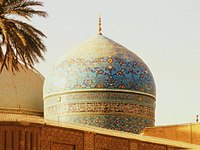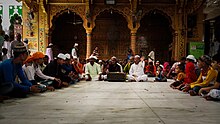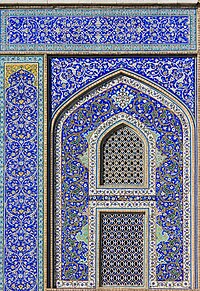| Part of a series on Islam Sufism |
|---|
 |
|
|





A dargah (Persian: درگاه dargâh or درگه dargah, Turkish: dergâh, Hindustani: dargāh दरगाह درگاہ, Bengali: দরগাহ dôrgah) is a shrine or tomb built over the grave of a revered religious figure, often a Sufi saint or dervish. Sufis often visit the shrine for ziyarat, a term associated with religious visitation and pilgrimages. Dargahs are often associated with Sufi eating and meeting rooms and hostels, called khanqah or hospices. They usually include a mosque, meeting rooms, Islamic religious schools (madrassas), residences for a teacher or caretaker, hospitals, and other buildings for community purposes.
The same structure, carrying the same social meanings and sites of the same kinds of ritual practices, is called maqam in the Arabic-speaking world.
Dargah today is considered to be place where saints prayed and mediated (their spiritual residence). Shrine is modern day building which encompasses of actual dargah as well but not always.
Etymology
[edit]Dargah is derived from a Persian word which literally means "portal" or "threshold."[1] The Persian word is a composite of "dar (در)" meaning "door, gate" and "gah (گاه)" meaning "place". It may have a connection or connotation with the Arabic word "darajah (دَرَجَة)" meaning "stature, prestige, dignity, order, place" or may also mean "status, position, rank, echelon, class" Some Sufi and other Muslims believe that dargahs are portals by which they can invoke the deceased saint's intercession and blessing (as per tawassul, also known as dawat-e qaboor[2][Persian: da‘wat-i qabũrدعوتِ قبور, "invocations of the graves or tombs"] or ‘ilm-e dawat [Persian: ‘ilm-i da‘wat عِلمِ دعوت, "knowledge of invocations"]). Still others hold a less important view of dargahs, and simply visit as a means of paying their respects to deceased pious individuals or to pray at the sites for perceived spiritual benefits.
However, dargah is originally a core concept in Islamic Sufism and holds great importance for the followers of Sufi saints. Many Muslims believe their wishes are fulfilled after they offer prayer or service at a dargah of the saint they follow. Devotees tie threads of mannat (Persian: منّت, "grace, favour, praise") at dargahs and contribute to langar and pray at dargahs.
Over time, musical offerings of dervishes and sheikhs in the presence of the devout at these shrines, usually impromptu or on the occasion of Urs, gave rise to musical genres like Qawwali and Kafi, wherein Sufi poetry is accompanied by music and sung as an offering to a murshid, a type of Sufi spiritual instructor. Today they have become a popular form of music and entertainment throughout South Asia, with exponents like Nusrat Fateh Ali Khan and Abida Parveen taking their music to various parts of the world.[3][4]
Throughout the non-Arab Muslim world
[edit]Sufi shrines are found in many Muslim communities throughout the world and are called by many names. The term dargah is common in the Persian-influenced Islamic world, notably in Iran, Turkey and South Asia.[5]
In South Africa, the term is used to describe shrines in the Durban area where there is a strong Indian presence, while the term keramat is more commonly used in Cape Town, where there is a strong Cape Malay culture.[6]
In South Asia, dargahs are often the site of festivals (milad) held in honor of the deceased saint on the anniversary of his death (urs). The shrine is illuminated with candles or strings of electric lights at this time.[7] Dargahs in South Asia, have historically been a place for all faiths since the medieval times; for example, the Ajmer Sharif Dargah was a meeting place for Hindus and Muslims to pay respect and even to the revered Saint Mu'in al-Din Chishti.[8][9]
In China, the term gongbei is usually used for shrine complexes centered around a Sufi saint's tomb.[10]
Worldwide
[edit]There are many active dargahs open to the public worldwide where aspirants may go for a retreat. The following is a list of dargahs open to the public.
- Shrine of Shaykh Abdul Qadir Gilani in Baghdad, Iraq
- Shrine of Khawaja Moinuddin Chishti, Ajmer Sharif Dargah, Ajmer, Rajasthan, India
- Shrine of Ahmad Ullah Maizbhandari in Chittagong, Bangladesh
- Shrine of Syed Shah Wilayat Naqvi, Amroha, India
- Shrine of Lal Shahbaz Qalandar in Sehwan Sharif, Pakistan
- Shrine of Pir Hadi Hassan Bux Shah Jilani in Duthro Sharif, Pakistan
- Shrine of Baba Bulleh Shah in Kasur, Pakistan
- Shrine of Piran Kaliyar in, Roorkee, India.
- Shrine of Murshid Nadir Ali Shah in Sehwan Sharif, Pakistan
- Shrine of Data Ganj Bakhsh Ali al-Hujwiri, Data Darbar, Lahore, Pakistan
- Shrine of Shah Jalal in Sylhet, Bangladesh
- Shrine of Ashraf Jahangir Semnani at Ashrafpur Kichhauchha, Uttar Pradesh, India
- Shrine of Shah Ata in Gangarampur, West Bengal, India[11]
- Shrine of Syed Ibrahim Badshah Shaheed, Erwadi, Tamil Nadu, India
- Shrine of Nagore Dargah, Nagore, Tamil Nadu, India
- Shrine of Sulthan Sikandhar Badhusha Shaheed, Thiruparankundram Dargah, Tamil Nadu, India
- Shrine of Meer Ahmad Ibrahim, Madurai Hazrat Maqbara, Madurai, Tamil Nadu, India[12]
- Shrine of Shaykh Nazim Al-Haqqani in Lefka, Cyprus[13]
Opposition by other Sunni groups
[edit]The Ahl-i Hadith, Deobandi, Salafi and Wahhabi religious scholars argue against the practice of constructing shrines over graves, and consider it as associating partners with God, which is called shirk.[14] They believe Islamic prophet Muhammad strongly condemned the practice of turning graves into places of worship and even cursed those who did so.[15][16] The current Wahhabi rulers of Saudi Arabia have destroyed more than 1400-year-old grave sites of companions and ahl al-bayt including Othman, Khadija and Aisha amongst numerous others,[17][18][19] although visiting graves is encouraged in Islam to remember death and the Day of Judgment.[19][20][21]
Sufi Defence on Permissibility of Dargah
[edit]Sufis, refute such claims on the basis of misquotation of hadith. The hadith "Let there be curse of Allah upon the Jews and the Christians for they have taken the graves of their apostles as places of worship.(Sahih Muslim)",[22] is directed towards the disbelievers not the Muslims who took graves as place of worship i.e. they prayed facing towards the graves, this is not the practice of Sufis as they do not take graves as their Qibla (direction). As for constructing structure over grave, it is refuted on the basis that the grave of Prophet Muhammad and the first two Khalifa, Abu Bakr and Umar, itself have a structure over it.
To construct a building, shelter or edifice around the graves of the Auliya Allah (Friends of Allah) and Scholars of Islam or nearby is proven to be permissible from the Quran and practice and rulings of the Sahaba,.
Narrating the incident of the People of the Cave [Ashaab-e-Kahf), the Holy Quran states, “The person who was dominant in this matter said, “We shall build a Masjid over the People of the Cave.”– [Surah Kahf. Verse 21]
Imam Fakhr al-Din al-Razi explains the above Quran verse in his famous Tafsir al Kabeer, "And when Allah said {Those who prevailed over their affair} this refers to the Muslim ruler or the friends of Ashaab al Kahf (i.e. believers) or the leaders of town. {We will surely build a Mosque over them} so that we can worship Allah in it and preserve the relics of companions of the cave due to this mosque” [Tafsir al-Kabeer, 5/475].
Imam Abu al-Walid al-Baji, quotes in his book Al-Muntaqa Sharh al-Muwatta (commentary of Muwatta Imam Malik), "Hadrat Umar built a dome over the grave of Hadrat Zainab bint Jahsh, and Sayyidah Aisha on the grave of her brother Hadrat Abdur-Rahman and Hadrat Muhammad ibn al-Hanafiyya on the grave of Hadrat Ibn Abbas. So Whoever has classified building domes to be disliked (Makrooh) has said so if they are built in order to show off. (Imam Badr al-Din al-Ayni, also writes the same in his book Umdat al-Qari - commentary of Sahih Bukhari) [23]
See also
[edit]Bibliography
[edit]- Ernst, Carl W. The Spirituality of the Sufi Shrine – Chapter 9, The Wiley Blackwell Companion to Islamic Spirituality, 2022. pp. 165–179. doi:10.1002/9781118533789.ch9
References
[edit]- ^ Delage, Remy; Boivin, Michel (2015). Devotional Islam in Contemporary South Asia: Shrines, Journeys and Wanderers. Routledge. ISBN 978-1317380009.
- ^ Bilgrami, Fatima Zehra (2005). History of the Qadiri Order in India. Idarah-i Adabiyat-i Delli. p. 291.
- ^ Kafi South Asian folklore: an encyclopedia : Afghanistan, Bangladesh, India, Nepal, Pakistan, Sri Lanka, by Peter J. Claus, Sarah Diamond, Margaret Ann Mills. Taylor & Francis, 2003. ISBN 0-415-93919-4. p. 317.
- ^ Kafi Crossing boundaries, by Geeti Sen. Orient Blackswan, 1998. ISBN 8125013415. p. 133.
- ^ Alkazi, Feisal (2014). Srinagar: An Architectural Legacy. New Delhi: Roli Books. ISBN 978-9351940517.
- ^ Acri, Andrea; Ghani, Kashshaf; Jha, Murari K.; Mukherjee, Sraman (2019). Imagining Asia(s): Networks, Actors, Sites. Singapore: ISEAS. ISBN 978-9814818858.
- ^ Currim, Mumtaz; Michell, George (1 September 2004). Dargahs, Abodes of the Saints. Mumbai: Marg Publications. ISBN 978-8185026657.
- ^ Khan, Motiur Rahman (2010). "Akbar and the Dargah of Ajmer". Proceedings of the Indian History Congress. 71. Idarah-i Adabiyat-i Delli: 226–235. ISSN 2249-1937. JSTOR 44147489.
- ^ "How Dargahs Unite People Of All Faiths". nayadaur.tv. 24 November 2020.
- ^ "Muslim Architecture". China.org. Retrieved 2020-06-07.
- ^ "History of Dargah of Shah Ata". Asikolkata.in. ASI, Kolkata Circle. Retrieved 2017-08-22.
- ^ "Maqbara.com – Madurai Hazraths Maqbara".
- ^ "Sheikh Nazım Al Haqqani Al Qubrusi An Naqshibandi". Retrieved 6 April 2016.
- ^ "Building Mosques or Placing Lights on Graves" (PDF). 21 March 2008. Retrieved 11 July 2014.
- ^ "Sahih Muslim 528a – The Book of Mosques and Places of Prayer – Sunnah.com – Sayings and Teachings of Prophet Muhammad (صلى الله عليه و سلم)".
- ^ "Sahih al-Bukhari 3453, 3454 – Prophets – Sunnah.com – Sayings and Teachings of Prophet Muhammad (صلى الله عليه و سلم)".
- ^ "Sunan an-Nasa'i 2048 – The Book of Funerals – Sunnah.com – Sayings and Teachings of Prophet Muhammad (صلى الله عليه و سلم)". sunnah.com.
- ^ "Sunan an-Nasa'i 2047 – The Book of Funerals – Sunnah.com – Sayings and Teachings of Prophet Muhammad (صلى الله عليه و سلم)". sunnah.com.
- ^ a b Ondrej, Beranek; Tupek, Pavel (July 2009). Naghmeh, Sohrabi (ed.). From Visiting Graves to Their Destruction: The Question of Ziyara through the Eyes of Salafis (PDF). Crown Paper (Crown Center for Middle East Studies/Brandeis University). Brandeis University. Crown Center for Middle East Studies. p. 19. Archived (PDF) from the original on 10 August 2018.
Relying mainly on hadiths and the Qur'an, Ibn 'Abd al-Wahhab's most famous work, The Book of God's Unicity (Kitab al-tawhid), describes a variety of shirk practices, such as occultism, the cult of the righteous (salih), intercession, oaths calling on other than God himself, sacrifices or invocational prayers to other than God, and asking other than Him for help. Important things about graves are remarked on in a chapter entitled "About the Condemnation of One Who Worships Allah at the Grave of a Righteous Man, and What if He Worships [the Dead] Himself."72 Ibn 'Abd al-Wahhab starts by quoting a hadith: "Umm Salama told the messenger of Allah about a church she had seen in Abyssinia in which there were pictures. The Prophet said: 'Those people, when a righteous member of their community or a pious slave dies, they build a mosque over his grave and paint images thereon; they are for God wicked people.' They combine two kinds of fitna: the fitna of graves and the fitna of images." He then continues with another hadith: "When the messenger of Allah was close to death, he ... said: 'May Allah curse the Jews and Christians who make the graves of their prophets into places of worship; do not imitate them.'" From this hadith Ibn 'Abd al-Wahhab derives the prohibition of building places of worship over graves, because that would mean glorification of their inhabitants, which would amount to an act of worship to other than Allah.
- ^ "The Book of Prayer – Funerals – Sahih Muslim". Sunnah.com – Sayings and Teachings of Prophet Muhammad (صلى الله عليه و سلم). Retrieved 6 April 2016.
- ^ "Shrine – Oxford Islamic Studies Online". www.oxfordislamicstudies.com. Archived from the original on February 24, 2021. Retrieved 2018-08-10.
Many modern Islamic reformers criticize visits to shrines as mere superstition and a deviation from true Islam.
- ^ "Sahih Muslim 530b - The Book of Mosques and Places of Prayer - Sunnah.com - Sayings and Teachings of Prophet Muhammad (صلى الله عليه و سلم)". sunnah.com. Retrieved 2024-01-30.
- ^ Published : idarat al-ittabah al-Muniriya Qahira Egypt, Vol 8, Page 134.
| Styles | ||||||||||||||||||||
|---|---|---|---|---|---|---|---|---|---|---|---|---|---|---|---|---|---|---|---|---|
| Elements |
| |||||||||||||||||||
| Types |
| |||||||||||||||||||
| Resources | ||||||||||||||||||||
| Influences | ||||||||||||||||||||
| Category pages | ||||||||||||||||||||
Sufism terminology | ||
|---|---|---|
| Sufis | ||
| Concepts | ||
| Awrad | ||
| Waridates | ||
| Misconducts | ||
| Ceremonies | ||
| Arts | ||
| Places | ||
| Objects | ||

